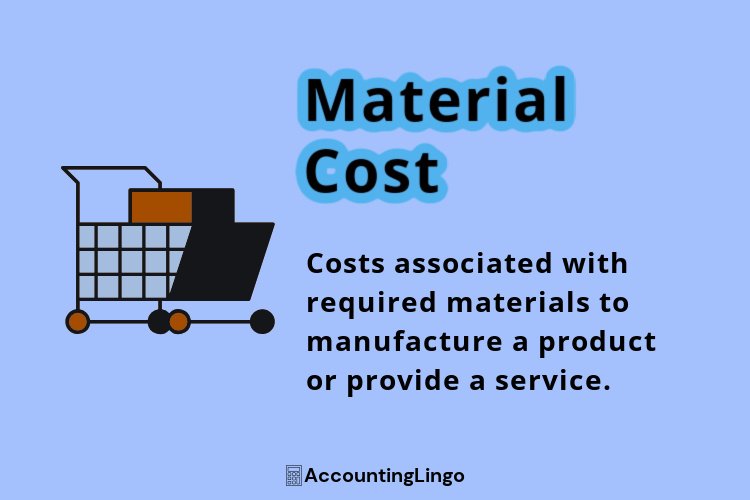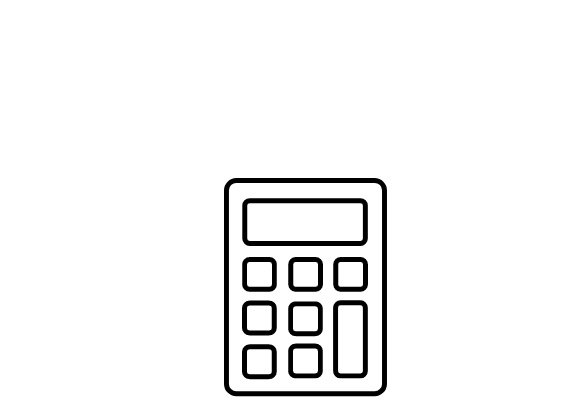
Understanding how to calculate and manage material cost is crucial for success whether you’re an experienced business owner or just starting out.
In this guide, we’ll explain and review factors that influence material costs, such as supply and demand, market trends, and production processes.
What is Material Cost?
Material cost is defined as costs associated with required materials to manufacture a product or provide a service. Understanding these costs is important for businesses of all sizes. Whether manufacturing products or providing services, material costs can significantly impact the bottom line.
A key benefit in understanding material costs is the ability to estimate the cost of production accurately. This ensures you set competitive prices for your products or services without overcharging customers or leaving money on the table.
In addition, by tracking material costs, you can ensure that you have adequate stock on hand to meet customer demand without tying up excessive inventory capital. This can help improve cash flows while reducing the risk of stockouts or overstock situations.
Factors Affecting Material Cost
Several factors influence costs. Understanding these factors is essential for accurate cost estimation and management.
Supply & Demand
The basic principles of supply and demand have a tremendous effect on pricing. When demand exceeds supply for a certain material type, prices often rise. Conversely, when supply exceeds demand, prices often fall. Understanding these dynamics within an industry can help one anticipate and react to such changes proactively.
Market Trends
Market trends, like changes in consumer preferences or technological advances, may also impact material costs. For example, prices may increase if a surge in demand for a certain material type occurs due to a new trend. Remaining informed regarding market trends can help you stay ahead of competing businesses.
Production Processes
The production cycle involves transforming raw materials into finished products. A complex production process can require additional materials or special equipment, driving up costs. Furthermore, the production process can help you identify cost-saving opportunities or lead to alternative manufacturing methods.
Types of Material Cost
It’s important to understand cost types. Businesses typically encounter two primary types.
Direct Material Cost
This involves products used to produce goods or services. Examples include raw materials like wood, silver, aluminum, components, or other items necessary to produce a final product. Additionally, this is the largest cost type and should be monitored closely to ensure accurate estimation.
Indirect Material Cost
This involves products not directly used in the production process but are required for day-to-day operations. Examples may include maintenance materials like cotton pads to clean machines, oil, glue, or any other materials that support the production process. These costs also need to be accounted for to ensure accurate cost estimation.
Material Cost Calculation
Accurately calculating direct and indirect costs is essential for businesses looking to optimize profitability. Although calculation methods vary depending on the industry, one can follow the below general steps to calculate and assign unit of production costs.
1. Identify Materials
The first step is identifying all materials required for the production process. This includes both direct and indirect materials. Make a comprehensive list of all needed items.
2. Determine Quantity
After required items have been identified, factor the quantity of material required for the production process. This may be done by reviewing past production records, consulting with suppliers, or analyzing time and motion studies.
3. Determine Unit Cost
After determining the quantity, define the unit cost of each material. This can be obtained by contacting suppliers, conducting market research, or analyzing historical purchasing data. Considering factors such as bulk discounts, shipping costs, and other additional expenses associated with acquiring the materials is essential.
4. Calculate Total Material Cost
Multiply the quantity of each material by its unit cost to calculate the total cost. Sum up the total to obtain the overall cost for a specific production run or project.
Example
1,000 pieces of fabric (quantity) x $2 (unit cost) = $2,000 (total cost)
5 gallons of glue (quantity) x $8 (unit cost) = $40 (total cost)
$2,000 (total cost) + $40 (total cost) = $2,040 (total material cost)
5. Consider Other Factors
In addition to the direct costs of materials, consider other factors that may impact overall costs, such as waste, scrap, or spoilage. These factors should also be included.
Reducing Material Cost
Cost reduction is often a priority for companies seeking profitability improvements. Let’s explore reduction strategies often used without compromising quality or customer satisfaction.
Supplier Negotiations
Companies can secure better pricing, bulk discounts, and other saving strategies by building strong relationships with suppliers in order to negotiate favorable terms. Regularly reviewing existing supplier contracts and exploring alternatives can help businesses identify cost-saving opportunities.
Value Engineering
Value engineering is a systematic approach to reducing costs while maintaining or improving product quality without compromising performance or functionality. It involves re-evaluating the design, materials, and production methods to identify saving opportunities.
Lean Manufacturing
Lean manufacturing principles focus on eliminating waste and optimizing production processes. By utilizing techniques such as just-in-time inventory management, reducing setup times, and improving production efficiency, businesses can minimize waste.
Material Substitution
Exploring alternative products may help reduce expenditures. By researching and evaluating different materials, businesses can identify options that offer similar performance but at a lower cost. It’s important to consider factors such as quality, availability, and compatibility with existing production processes.
Waste Reduction
Minimizing waste or nonconformance costs is also a key reduction strategy. Waste minimization techniques like recycling, reusing scrap materials, or optimizing material handling processes may allow businesses to reduce the amount of waste, thereby reducing costs.
Material Cost Challenges
Managing material expenditures can present several challenges for businesses. Let’s explore common challenges and common ways to address them.
Fluctuating Material Prices
Market dynamics, supply and demand, along with other factors may cause varying material prices over time. Remaining informed of market trends, establishing strong supplier relationships, and implementing purchasing strategies such as forward contracts or hedging can help address this challenge.
Supplier Reliability
Late deliveries, quality issues, or sudden disruptions in the supply chain can lead to higher pricing and production delays. Therefore, companies should carefully evaluate suppliers, have backup suppliers, and ensure lines of communication remain open to address issues proactively.
Inaccurate Cost Estimation
Estimation requires careful analysis and consideration of various factors. To address this challenge, businesses should invest in cost estimation tools, regularly review and update estimation methods, and ensure effective communication between the purchasing and production departments.
Lack of Visibility
Lack of inventory visibility can make it challenging to manage costs effectively. Therefore, businesses should implement robust inventory management systems, leverage technology solutions like enterprise resource planning (ERP) software, and establish clear communication channels between departments involved in material management.
Tools: Managing Material Cost
Effective management requires the right tools and resources. Fortunately, there are several options to help oversee this process.
Cost Estimation Software
Estimation software can help businesses accurately project material costs by automating the calculation process while considering factors such as additional expenses. These solutions often provide advanced features like historical cost tracking, supplier performance analysis, and scenario modeling.
Inventory Management Systems
Robust inventory management systems are crucial. They help businesses track inventory levels, monitor usage, and optimize reorder points. By leveraging these systems, companies can reduce stockouts and minimize excess inventory.
Relationship Management Tools
Supplier relationship management tools help businesses effectively manage their relationships. These tools often provide features such as supplier scorecards, contract management, and communication portals, allowing businesses to optimize their relationships and drive cost savings.
Market Research & Analysis
Staying informed about market trends and industry dynamics is essential for managing material costs. Businesses can leverage market research reports, industry publications, and online resources to gain insights into market trends, pricing dynamics, and potential savings opportunities.
Professional Networks
Joining professional networks and associations can provide businesses access to valuable insights, best practices, and industry-specific resources. Furthermore, these networks often offer educational events, networking opportunities, and forums for knowledge sharing, helping businesses stay up-to-date with the latest strategies.
Cost Reduction Examples
Examples can provide valuable insights into successful material cost management strategies. Let’s explore a few scenarios.
Example 1: Auto Manufacturer
An automotive manufacturer implemented lean manufacturing principles to optimize their material cost management processes. By eliminating waste, reducing setup times, and improving production efficiency, the company achieved a 15% reduction in expenditures while maintaining product quality.
Example 2: Construction Company
A construction company identified an opportunity for cost savings by substituting traditional building materials with more cost-effective alternatives. The company was able to reduce their expenditures by 20% without compromising the quality or durability of the structures.
Example 3: Retailer
A retailer implemented analytics tools to analyze sales data, inventory levels, and supplier performance. By leveraging data-driven insights, the company optimized purchasing decisions, negotiated better terms with suppliers, and reduced material costs by 10%.
Conclusion
Understanding material costs is essential for businesses looking to optimize profitability, make informed decisions, and gain a competitive edge.
Companies can achieve significant cost reductions and improve their bottom line by understanding factors influencing material costs, accurately calculating material costs, and implementing effective cost-saving strategies.
Additional Resources
Other helpful articles may include:
Merchandise Purchases Budget
Understanding Budgeted Cost
Cost Based Pricing Explained
What is Step Variable Cost?
